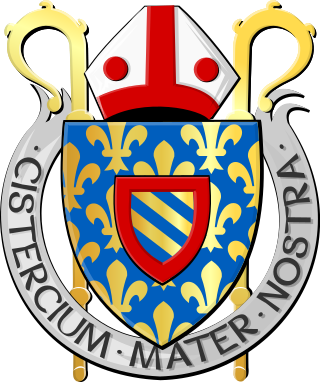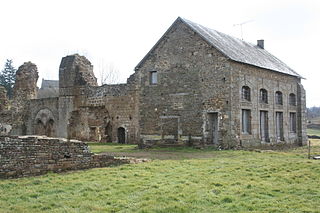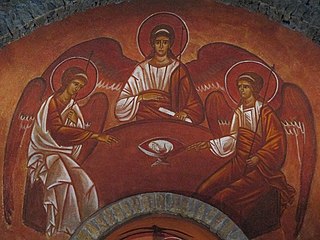
The Benedictines, officially the Order of Saint Benedict, are a mainly contemplative monastic order of the Catholic Church for men and for women who follow the Rule of Saint Benedict. Initiated in 529 they are the oldest of all the religious orders in the Latin Church. The male religious are also sometimes called the Black Monks, especially in English speaking countries, after the colour of their habits. Not all Benedictines wear black, however, with some like the Olivetans wearing white. They were founded by Benedict of Nursia, a 6th-century Italian monk who laid the foundations of Benedictine monasticism through the formulation of his Rule. Benedict's sister, Scholastica, possibly his twin, also became a religious from an early age, but chose to live as a hermit. They retained a close relationship until her death.

Bernard of Clairvaux, O. Cist., venerated as Saint Bernard, was an abbot, mystic, co-founder of the Knights Templar, and a major leader in the reform of the Benedictines through the nascent Cistercian Order.

Cîteaux Abbey is a Catholic abbey located in Saint-Nicolas-lès-Cîteaux, south of Dijon, France. It is notable for being the original house of the Order of Cistercians. Today, it belongs to the Trappists.

The Cistercians, officially the Order of Cistercians, are a Catholic religious order of monks and nuns that branched off from the Benedictines and follow the Rule of Saint Benedict, as well as the contributions of the highly-influential Bernard of Clairvaux, known as the Latin Rule. They are also known as Bernardines, after Saint Bernard himself, or as White Monks, in reference to the colour of the "cuculla" or cowl worn by the Cistercians over their habits, as opposed to the black cowl worn by Benedictines.

The Trappists, officially known as the Order of Cistercians of the Strict Observance and originally named the Order of Reformed Cistercians of Our Lady of La Trappe, are a Catholic religious order of cloistered monastics that branched off from the Cistercians. They follow the Rule of Saint Benedict and have communities of both monks and nuns that are known as Trappists and Trappistines, respectively. They are named after La Trappe Abbey, the monastery from which the movement and religious order originated. The movement first began with the reforms that Abbot Armand Jean le Bouthillier de Rancé introduced in 1664, later leading to the creation of Trappist congregations, and eventually the formal constitution as a separate religious order in 1892.

Gertrude the Great, OSB was a German Benedictine nun and mystic from the monastery of Helfta. She is recognized as a saint by the Catholic Church and figures in the General Roman Calendar on November 16 for optional celebration as a memorial throughout the Roman Rite.
St Bernard's Catholic Grammar School is an academically selective Roman Catholic state grammar school on Langley Road, Slough. It was previously designated as a Humanities College. The student body is divided into five different houses - Annay, Clairvaux, Cîteaux, La Plaine and Rievaulx as of June 2024. The houses are named after various monastic houses, relating to the school's history. The school's motto is "Dieu Mon Abri", which means "God is my Shelter". The crest is a diamond, with three parallel, diagonal, swords on a blue background. The school has been given an "outstanding" by Ofsted and its 2017, 2018 and 2019 results place it academically within the top 1% of the country.

The monastic Congregation of Savigny started in the abbey of Savigny, situated in northern France, on the confines of Normandy and Brittany, in the Diocese of Coutances. It originated in 1105 when Vitalis of Mortain established a hermitage in the forest at Savigny in France.

Cistercian nuns are female members of the Cistercian Order, a religious order of the Catholic Church.
Gerald of Sales was a French monastic reformer from Salles, Lot-et-Garonne near Bergerac, Dordogne in the south-west of France. His feast day is on April 20.

La Maigrauge Abbey or Magerau Abbey is a monastery of Cistercian nuns located in Fribourg, Switzerland, and founded in 1255. The abbey is situated on the Sarine River and lies on the border between French-speaking and German-speaking Switzerland. The community is bilingual.

The Feuillants were a Catholic congregation originating in the 1570s as a reform group within the Cistercians in its namesake Les Feuillants Abbey in France, which declared itself an independent order.

Molesme Abbey was a well-known Benedictine monastery in Molesme, in Laignes, Côte-d'Or, Duchy of Burgundy, on the border of the Dioceses of Langres and Troyes.

Soleilmont Abbey is an abbey of Trappistine nuns situated in the forest and commune of Fleurus, at Gilly near Charleroi, Belgium, founded, according to tradition, in the 11th century, which became Cistercian in 1237. The nuns were expelled as a consequence of the French Revolution in 1796, but soon re-established themselves in 1802. The community became Bernardine in 1837, and Trappist in 1919.

St Cecilia's Abbey, Ryde is an abbey of Benedictine nuns in the Isle of Wight, England.

The Monastic Family of Bethlehem, of the Assumption of the Virgin and of Saint Bruno – or simply known as Monastic Brothers of Bethlehem and Monastic Sisters of Bethlehem – is a Roman Catholic institute of consecrated life.
The Cistercian Hymnal is a compilation of the ancient texts and melodies sung by Cistercian monks and nuns during the Liturgy of the Hours. This collection of hymns influenced the Cistercian Order's identity, since early abbots emphasized the compositions' musical quality. The hymnal developed in the course of the centuries.
Chrysogonus Waddell was an American Roman Catholic convert and theologian. A Trappist monk of the Abbey of Gethsemani, Kentucky, he was an accomplished organist, liturgist, historian, and a scholar of chant and Cistercian liturgy.

The Monastery of Our Lady of Hyning is a community of Bernardine Cistercians in Warton, Lancaster, England, formerly known as St Bernard's Priory and informally called Hyning Monastery. Its grade II listed house has also been known as The Hyning, Hyning Priory, Hyning Hall and Hyning House. It is in the north of the parish of Warton, east of the road to Yealand Conyers.























